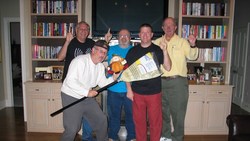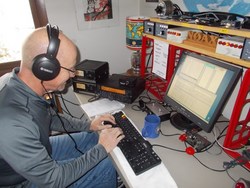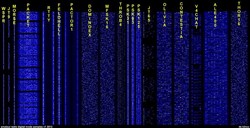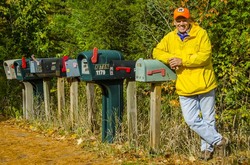 November 19, 2014 Editor: Ward Silver, NØAX | |||||||
IN THIS ISSUE
NEW HF OPERATORS - THINGS TO DO If you'd like some serious code practice, the Thanksgiving Day weekend is just what you need: the CQ World Wide CW Contest will bring out thousands and thousands of stations. They'll be sending a signal report and CQ Zone - be prepared to respond in kind! Once your code speed is up, how about going for a Code Proficiency Certificate on one of the ARRL's Code Qualifying Runs? BULLETINS Logs for Sweepstakes CW were due on Tuesday, Nov 18th - there might be time to yet send in your log, if you hurry! BUSTED QSOS No one seemed to have noticed anything amiss last time. CONTEST SUMMARY Complete information for all contests follows the Conversation section November 22-23
November 29-30
This December's ARRL 160 Meter and 10 Meter Contests complete the addition of new Single-Op Unlimited categories. All three power sub-categories: High Power, Low Power, and QRP are available. This means stations using spotting information will no longer be assigned to the Multioperator category. It also means there are quite a number of new records that will be set in December! Will your score be one of them?
It was pleasant to note all of the recent "checks" (year of first license) being exchanged during the Phone Sweepstakes this past weekend. Ralph N5RZ notes a very professional exchange on 10 meters with 8-year-old Samuel KG5AYI who called in from Louisiana. It would be great to see these folks on the air during the 10 Meter Contest in a few weeks - let's see if Ol' Sol cooperates with more solar flux and a quiet geomagnetic field! Having overcome some challenges, SuperBertha is stepping things up. Scott W3TX Phil K3TUF announced the East Coast VHF+ Super Conference which will be held in northern Virginia on April 15-17. Lots more information will be published on the conference website - keep checking! Who has the highest one-hour rate? The R5GA website has the results derived from public logs made available over the past few years. Those numbers represent 60 minutes of hard contest labor, not the entire contest! Click "DXCC" then select "K United States" to find the U.S. records. This month marks the one-year anniversary of a hard-fought naval battle near the North Atlantic in which the USS Connecticut prevailed over the USS Maine during the CQ World Wide CW Contest, setting an all-time record in the process! Hint - the resumes of both SOAB-HP top operators include a variety of experiences in the U.S. Navy. Web Site of the Week - Combining networking and radio savvy is leading to the creation of all sorts of interesting collective efforts. Most Contest Update readers are familiar with the Reverse Beacon Network and the NCDXF Beacon network. Well, winner of the 2014 Hackaday Prize, the SatNOGs team (Satellite Network Of Ground Stations) has built a worldwide system of open-source amateur satellite ground stations - I want one! Amateurs took home an additional prize, as well, with the PortableSDR project placing third. Well done! (Thanks, Bryce KB1LQC) WORD TO THE WISE Buckshot - spurious emissions from phone signals. If you were on during Phone Sweepstakes, you heard a lot of it, including a few big stations with pretty wide signals. Clean it up! While I'm on the subject, there were a number of stations with fairly crufty audio that made copy difficult. Check it out and tone it up - you'll get through quicker with fewer repeats!
The far side is more than an out-of-print cartoon, it's a view of the Sun that lets us know what's "coming round the bend". Take a look at the GONG project's farside images, including a month-long movie. It's hard to say what's going to be looking Earthward during CQ WW CW but there are some tantalizing hints! Dennis N6KI takes us on a video tour of the NX6T CW Sweepstakes multioperator station. Why, even Mr Bill is on the operator list! And the view is marvelous! Lots of new VHF+ contest results can be found on the ARRL website. For the June VHF Contest, look for the QST article's PDF along with Line Scores in the new K9JK extended format. The Searchable Database is also available. For the August UHF Contest, full results by K9JK are online along with Line Scores, Log Checking Reports, and the Searchable Database.
Claimed scores for the October 2014 School Club Roundup are now available online. It was a photo finish between K5LBJ in the Senior High School category and College/University entry W4DFU for the top score! Results for last week's Frequency Measuring Test have been published by Bruce WA7BNM. Conducted on 160, 80, and 40 meters, the "green box" shows who made the accuracy grade on all three bands. SV8QG even submitted excellent measurements on 80 and 40 meters - from Greece! Final results for the following National Contest Journal contests are now available on the NCJ website:
Final results for the fall Sprints will appear in the Jan/Feb 2015 NCJ. (Thanks, NCJ Editor Emeritus, Kirk K4RO) CQ World Wide Director, Randy K5ZD notes "The raw scores for the 2014 CQ WW DX Contest SSB are now available. These are the scores as calculated by our log checking software BEFORE any checking or score reductions have been done. These scores provide quick feedback on who might be the winners, but there is a lot of log checking still to go. It is not unusual for scores to drop 3-8% (or more) so we will have to wait until the checking is completed to know who the winners will be." In addition, the score listings have been re-arranged to make it easier to compare scores between Single-Op and Single-Op Assisted categories. Raw scores for the 2014 Worked All Germany contest are online. As for the CQ WW scores, raw scores are unchecked scores only. Late log submissions are still possible due to problems with the log upload shortly after the contest, in case you don't find your call in the list. (Thanks, WAG Contest Manager Chris DL8MBS) WRTC-2014 rate and breakdown reports for all team logs have been posted to the web site. Files were prepared from the raw logs as submitted. Thanks to Bob N6TV for providing the report files. (Thanks, Randy K5ZD) OPERATING TIP Please copy? Please don't! Imagine this pre-Sweepstakes conversation as Elmer prepares to hand off the controls to his protégée: Leave some extra room! Power system designer Gene AD3F suggests that when running cables, use conduit large enough so that the ultimate fill occupies only 40% of the area of the conduit. Two-inch conduit might seem to be large enough but even that first pull will be tough! Go all the way to four-inch as the cost is only slightly higher and you won't have the problem of an over-stuffed conduit. Gene reminds us to use "sweeps" with large radius curves and not sharp 90-degree elbows. This online article from EDN magazine gives a nice explanation of what s-parameters are and what they represent. Since antennas, like aircraft, are made from aluminum and stainless steel hardware, this Savvy Aviator article "Thwarting Corrosion" will be of interest. (Thanks, Mickey N4MB) Arggh - you opened the lid on that bottle of liquid electrical tape and it was solid because the solvent had slowly evaporated through the lid! Roger K8RI suggests putting the can inside a sealing food jar to slow down that solvent. It works for PVC pipe glue, too!
An alternative to installing special waterproof connectors on rotator cables is a waterproof outdoor utility box. The box keeps a terminal strip dry and "it is not difficult to disconnect the wires for occasional servicing. You can also install MOVs on this strip to protect your motor and indicator from lightning damage which may eliminate some rotator failures. A terminal strip...is easier than sealing and unsealing a "quick disconnect" and there is little risk of water ingress or corrosion. Disconnecting screw terminal wires is the easiest part of removing, repairing and replacing an antenna rotator." (Thanks, John KK9A) To minimize the torque on your rotator from the wind blowing on your antennas, install the antennas on opposite sides of the mast. This old trick results in a lot of torque canceling in the mast. (Thanks, Steve K7LXC) Magnetic loop antennas are popular for portable and stealthy operation. The loss mechanisms for these small antennas can rapidly eat up a signal, so it's important that losses be minimized. They are nicely characterized in the article "Loss Mechanisms in the Electrically Small Loop Antenna" in IEEE Antennas and Propagation Magazine, Vol 56, No 4, Aug 2014 by Austin (GØGSF), Boswell (G3NOQ), and Perks (ZS6BIM). Technical Web Site of the Week - Bell Labs, home of many great inventions and discoveries, is on its way back according to this EE Times article. Read up on the new Bell Labs Prize, as well! Thoughts on Spots Big excitement in the VHF+ contest community has erupted over the past few days due to a proposal made by the Ad Hoc Subcommittee on VHF and Above Revitalization. The full proposal is worth reading before offering your thoughtful input to the committee, but the two contentious pieces are: 1) Removal of the current prohibition on the use of Amateur and non-Amateur forms of assistance for all operator categories, with such use having no impact on entry category; and 2) Removal of the current prohibition on self-spotting for all operator categories
Basically, these boil down to eliminating the category distinction based on whether information about the operation of other participations crosses your station boundary and allow you to generate that information yourself (i.e. - "self-spot"). Not only that, you can do so online, a major shift in ARRL VHF contest policy. A third, less controversial item proposes to allow single-ops simultaneous transmissions on different bands. (Note - this is not a change being proposed for HF contests.) Why was this proposal made? It's no secret that ARRL VHF+ contest participation is down across the board, except for the June VHF Contest. June has largely become a 6 meter and 2 meter QSO party with the other bands far less popular. The CQ WW VHF Contest in July doesn't include the higher bands at all. Aside from those two contests, there are fewer and fewer operators outside of the major populated regions of the Northeast and Southwest willing to take on the challenges of VHF+ operating. With the amazing technology out there up into the GHz, it's a little bit crazy not to see that translating into more activity - at least on CW and SSB. Why is that? A number of correspondents with extensive VHF+ contest experience who are supportive of the proposals in various forums have mentioned frustration: Frustration at not being able to be heard or make contacts because of the nature of VHF+ antennas and propagation. This is particularly true for rover stations traveling through sparsely populated areas to activate grids. Story after story relates calling CQ after CQ with no takers because no one knows they are there! Frustration is a fancy way of saying "It's not fun." With data flowing in from every corner of the map, depriving one's self of it seems a bit strange. I know this is shocking, but the casual entrants (who we're counting on to become contest regulars) expect to turn on the radio and - brace yourself - make contacts! In more populous areas around North America and Europe, this is not a big problem. In the January and June contests, top stations in the Northeast and any station able to take advantage of sporadic E on 6 meters make around 1000 QSOs. Elsewhere, however, QSO totals fall off dramatically and so does the number of logs submitted. Thus the need to make some changes.
Was this an issue before? Propagation is about the same as it always was and the equipment is quite a bit better. In past years, though, there were no real-time tools available to help stations find each other. Today, knowing the data is out there and not being able to use it makes listening to receiver hiss and wearing out a rotator much less palatable. This drives participation down and as participation falls, so does the number of contacts in a mutually-reinforcing spiral. If these proposals are adopted, what would happen to tuning and listening skills? Realistically, getting contest "metadata" online means that you don't have to spend years learning the techniques of acquiring it on the air. While I am not a frequent VHF+ contester, I have spent time working with master HF contesters whose radio know-how is awesome. They've developed a sixth-sense for when bands open, to where, who's likely to be on the band, and so forth. A lot of that knowledge was the result of sheer stamina and perseverance - guts - to stay in the chair for contest after contest and learn. That's good and valuable, furthering the service's reasons for existence. However, we need to be honest with ourselves and recognize that fewer operators are willing to make the same effort to learn those skills on the VHF+ bands. Nevertheless, there is reason to give the proposal a try and evaluate the results over a few years. If more are encouraged to get on the air and make QSOs, there will be more stations to work for everybody. More contacts means more fun for stations using the data as well as stations who decide not to use the data. As more stations become active, there is an opportunity to promote connection-free operating practices. After all, the station and operator still have to be good enough to actually make the QSO from point to point. One way of promoting connection-less operating is to recognize it in an "extended line score," first proposed by N5KO a few years ago. Instead of maintaining separate single-op categories with separate listings, for example, combine the listings and let each station identify the way they chose to operate; with or without external data, one radio or multiple radios, and so on. Perhaps all we really need is three listing groups: Single-Op, Rovers, Multiop. Add the various attributes and let the data speak for itself, especially since it is downloadable and can be sorted however the reader wants. Another option is to reserve or create one contest or contest periods for completely connection-less operating. This gives all stations - the analog and the assisted - a home where they can compete with their peers on a basis they choose. Yes, this takes the hybridization of ham radio and the Internet another step farther. No two ways about it. However, in case you hadn't noticed, everything is hybridized with the Internet. That means we'll have to work harder to insure radio know-how remains the dominant path to success on the air. Awards and challenges can be sponsored for operating without external data, for example. The goal must be that more operators learn how to communicate effectively on VHF+ and see that as a valuable thing. The first step is to get them on the air. 19 November through 2 December An expanded, downloadable version of QST's Contest Corral in PDF format is available. Check the sponsor's Web site for information on operating time restrictions and other instructions. HF CONTESTS NAQCC Monthly QRP Sprint--CW, from Nov 20, 0130Z to Nov 20, 0330Z. Bands (MHz): 3.5-14. Monthly on 2nd Tuesday or 3rd Wednesday local time (alternating). Exchange: RST, S/P/C, and NAQCC mbr nr or power. Logs due: 4 days. Rules LZ DX Contest--Phone,CW, from Nov 22, 1200Z to Nov 23, 1200Z. Bands (MHz): 3.5-28. Exchange: RST and ITU Zone or LZ district. Logs due: 30 days. Rules SKCC Straight Key Sprint--CW, from Nov 26, 0000Z to Nov 26, 0200Z. Bands (MHz): 1.8-28, 50, Monthly on the fourth Wednesday UTC. Exchange: RST, S/P/C, name, SKCC nr or power. Logs due: 5 days. Rules Top Band Sprint--Phone,CW, from Nov 27, 0000Z to Nov 27, 0600Z. Bands (MHz): 1.8. Exchange: RST, S/P/C, ARCI number or Power. Logs due: 14 days. Rules CQ World Wide CW Contest--CW, from Nov 29, 0000Z to Nov 30, 2359Z. Bands (MHz): 1.8-28. Exchange: RST and CQ zone. Logs due: 5 days. Rules Full Day of Hell--Digital, from Nov 29, 0000Z to Nov 29, 2359Z. Bands (MHz): 1.8-28. Exchange: RST, S/P/C, Feld-Hell mbr nr, 4-char grid square. Logs due: 7 days. Rules VHF+ CONTESTS SKCC Straight Key Sprint--CW, from Nov 26, 0000Z to Nov 26, 0200Z. Bands (MHz): 1.8-28, 50, Monthly on the fourth Wednesday UTC. Exchange: RST, S/P/C, name, SKCC nr or power. Logs due: 5 days. Rules LOG DUE DATES 19 November through 2 December
ARRL Information Click here to advertise in this newsletter, space subject to availability. Your One-Stop Resource for Amateur Radio News and Information ARRL membership includes QST, Amateur Radio's most popular and informative journal, delivered to your mailbox each month. Subscribe to NCJ - the National Contest Journal. Published bimonthly, features articles by top contesters, letters, hints, statistics, scores, NA Sprint and QSO Parties. Subscribe to QEX - A Forum for Communications Experimenters. Published bimonthly, features technical articles, construction projects, columns and other items of interest to radio amateurs and communications professionals. Free of charge to ARRL members: Subscribe to The ARRL Letter (weekly digest of news and information), the ARES E-Letter (monthly public service and emergency communications news), Division and Section news -- and much more! ARRL offers a wide array of products to enhance your enjoyment of Amateur Radio. Visit the site often for new publications, specials and sales. Donate to the fund of your choice -- support programs not funded by member dues! Reprint permission can be obtained by sending email to permission@arrl.org with a description of the material and the reprint publication. ACKNOWLEDGEMENTS ARRL Contest Update wishes to acknowledge information from WA7BNM's Contest Calendar and SM3CER's Contest Calendar. | |||||||




.jpg)







